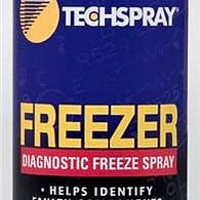1672-15S Techspray, 1672-15S Datasheet - Page 4

1672-15S
Manufacturer Part Number
1672-15S
Description
Chemicals Freezer,15oz aerosol
Manufacturer
Techspray
Type
Sprayr
Datasheet
1.1672-10S.pdf
(6 pages)
Specifications of 1672-15S
Product
Freeze Sprays
Chemical Component
1, 1, 1, 2-Tetrafluoroethane
Dispensing Method
Aerosol
Primary Type
Freezer
Special Features
Non-Flammable
Weight
15 Oz.
Lead Free Status / RoHS Status
Lead free / RoHS Compliant
6. ACCIDENTAL RELEASE MEASURES
7. HANDLING AND STORAGE
8. EXPOSURE CONTROLS / PERSONAL PROTECTION
Chemical Name
1,1,1,2-Tetrafluoroethane (HFC-134a)
Freezer
However, this material may become combustible when mixed with air under pressure and exposed to strong ignition
sources.
FIRE FIGHTING PROCEDURES: Use water spray to cool containers.
FIRE FIGHTING EQUIPMENT: As in any fire, wear self-contained breathing apparatus pressure-demand,
(MSHA/NIOSH approved or equivalent) and full protective gear.
COMMENTS: *Based on ASHRAE Standard 34 with match ignition.
GENERAL PROCEDURES: Isolate hazard area. Keep unnecessary and unprotected personnel from entering.
RELEASE NOTES: Spills and releases may have to be reported to Federal and/or local authorities.
HANDLING: Follow standard safety precautions for handling and use of compressed gas cylinders.
STORAGE: Store in a cool place in original container and protect from sunlight.
EXPOSURE GUIDELINES:
ENGINEERING CONTROLS: Local exhaust ventilation may be necessary to control any air contaminants to
within their TLVs during the use of this product.
PERSONAL PROTECTIVE EQUIPMENT
OSHA HAZARDOUS COMPONENTS (29 CFR 1910.1200)
OSHA TABLE COMMENTS:
1. * (AEL)=Acceptable Exposure Limit as established by the manufacture
EYES AND FACE: Wear safety glasses with side shields (or goggles) and a face shield.
SKIN: Skin contact with liquid may cause frostbite. General work clothing and gloves (leather) should provide
adequate protection. If prolonged contact with the liquid or gas is anticipated, insulated gloves constructed of
PVA, neoprene or butyl rubber should be used. Any contaminated clothing should be promptly removed and
washed before reuse.
TWA NE
OSHA PEL
ppm
mg/m
3
EXPOSURE LIMITS
ACGIH TLV
ppm
NE
mg/m
3
Supplier OEL
ppm
1,000
ppm
[1]
mg/m
3





